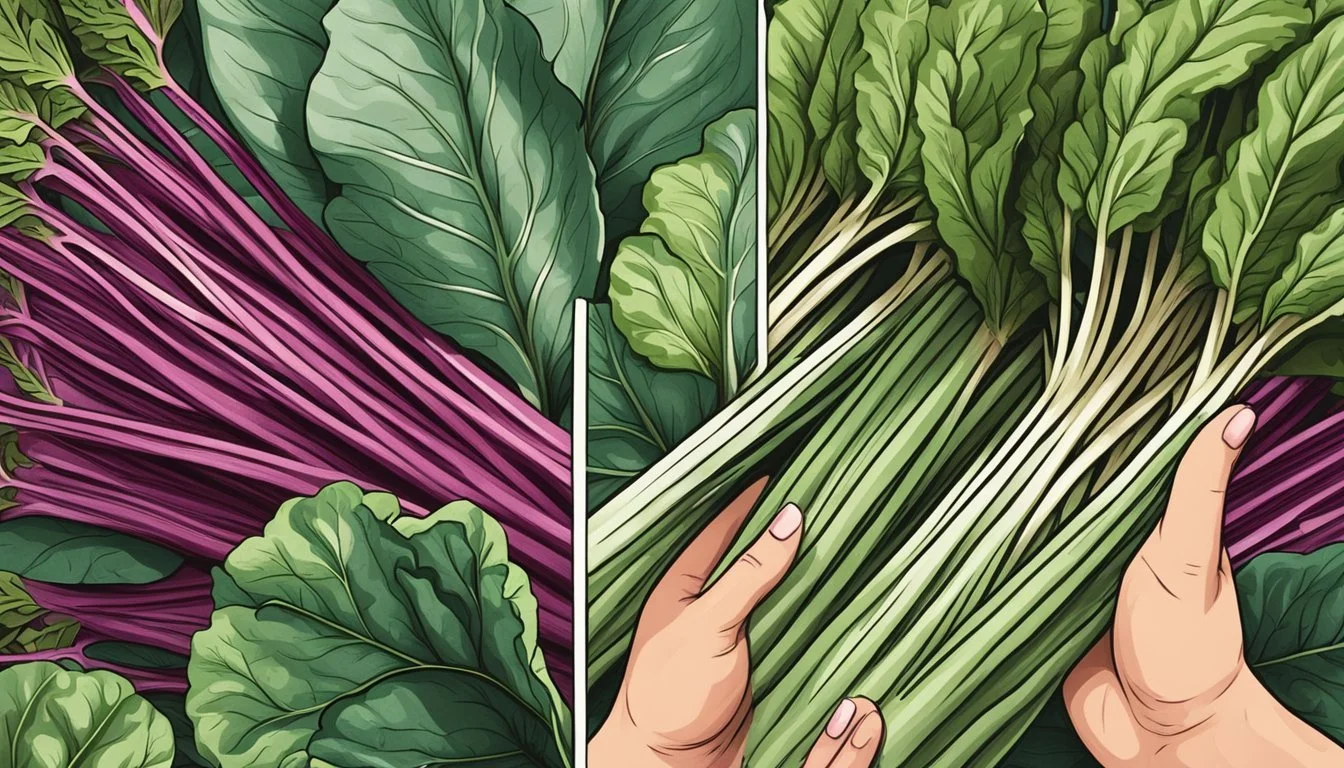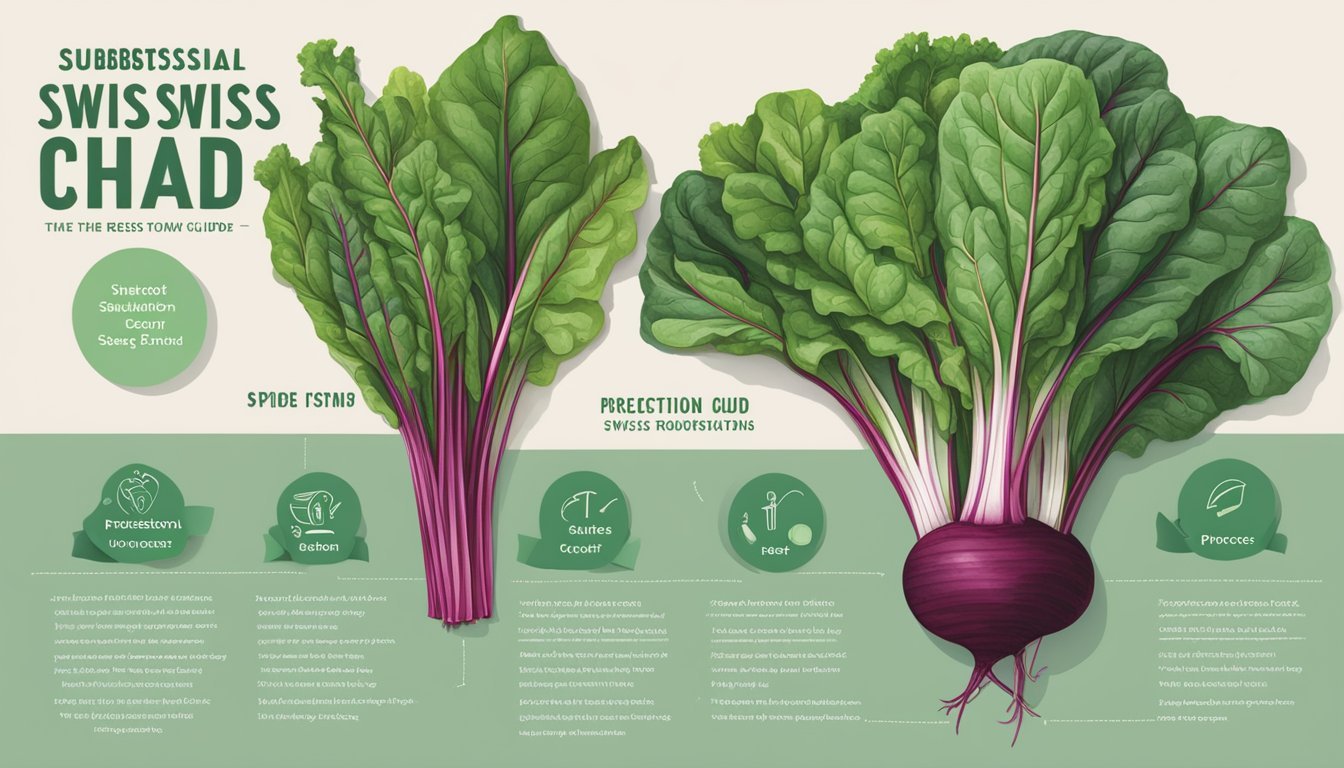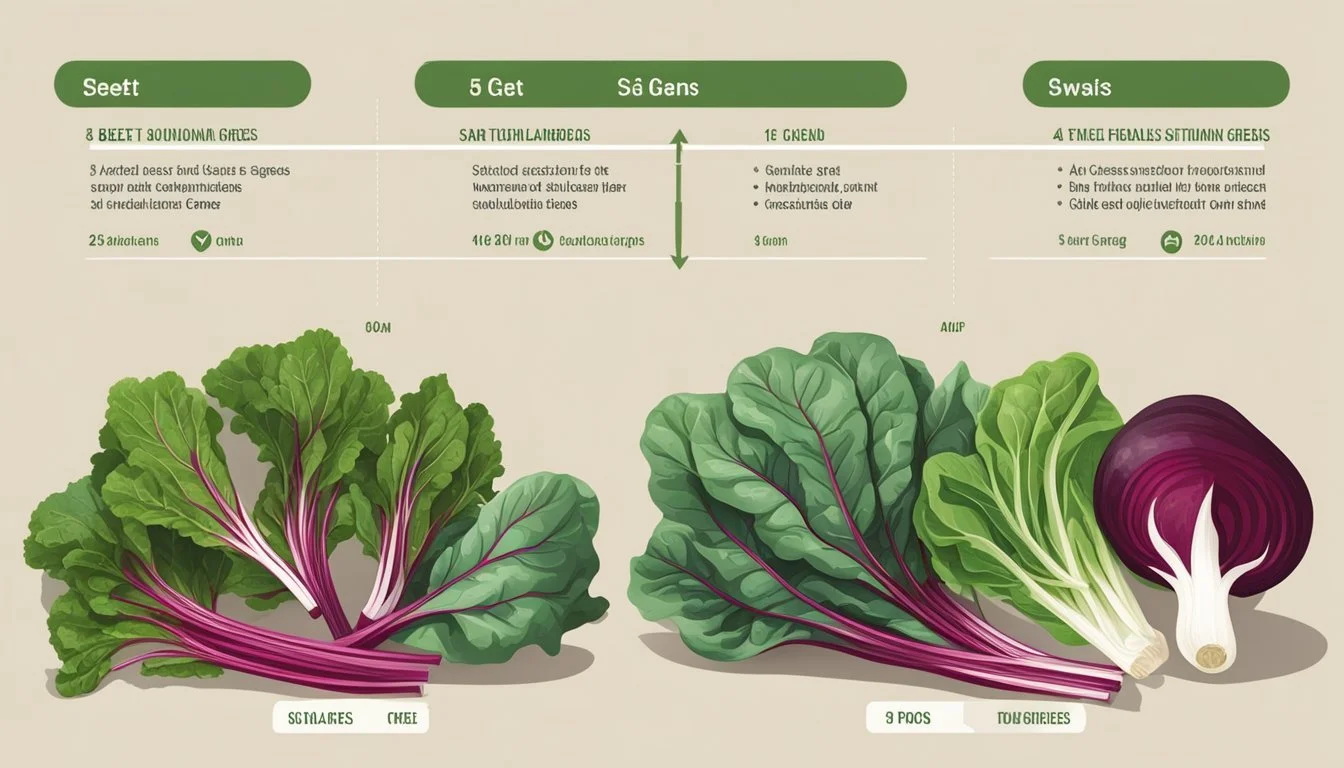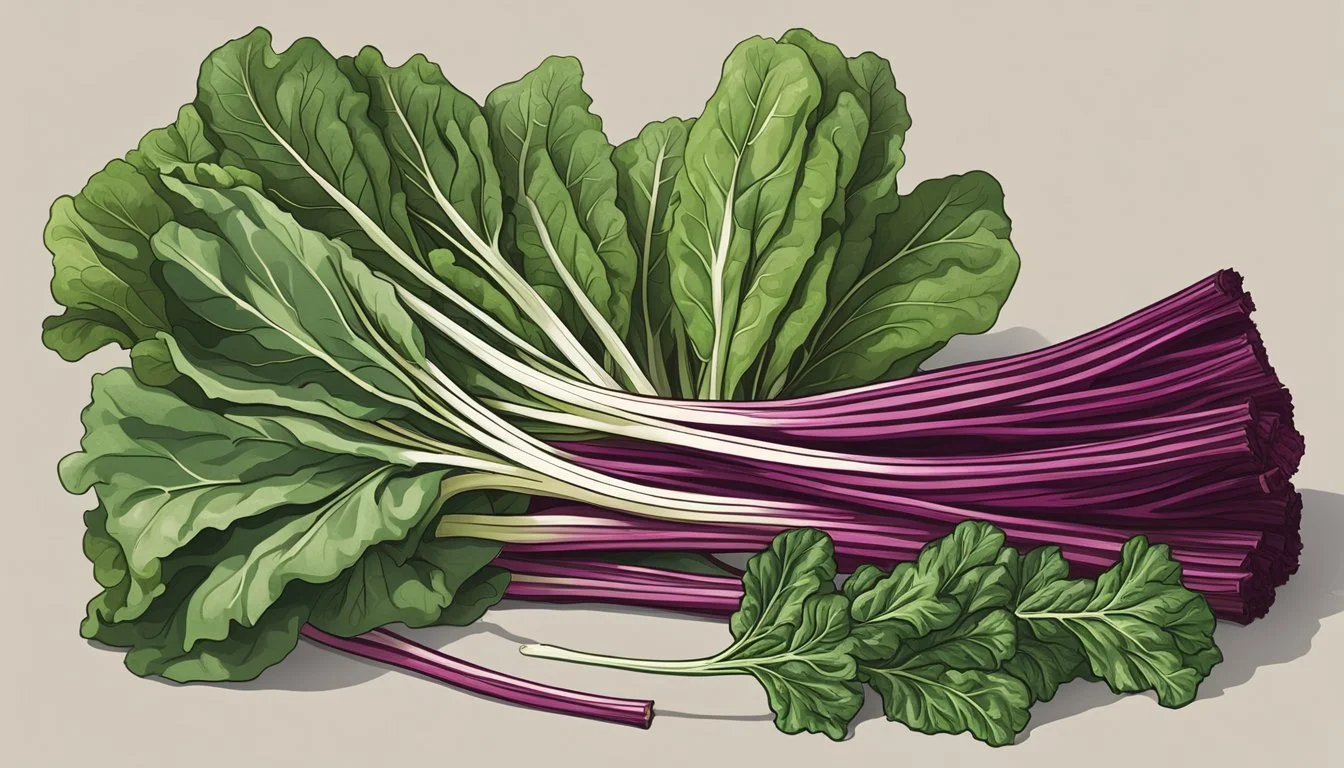How to Substitute Beet Greens for Swiss Chard
A Simple Guide
When it comes to leafy greens, Swiss chard often stands out for its vibrant color and nutritional value. However, there are times when this vegetable might not be available, or one may seek an alternative with a different nutritional profile or flavor. Beet greens present a suitable substitute, as they share a similar texture and slight bitterness with Swiss chard. In fact, beet greens, which come from the same family as Swiss chard, offer a comparable taste and nutritional benefits, making them an excellent choice for those looking to diversify their leafy green intake.
Beet greens can effectively replace Swiss chard in a wide range of recipes, from salads and soups to stews and sautés. They have a softer texture that becomes especially velvety when cooked, providing a subtle variation to dishes usually made with Swiss chard. The milder taste of beet greens can also be preferable for those who find the robust flavor of Swiss chard slightly overpowering. They are not only the leaves of the beet plant but a culinary gem that often goes unnoticed, typically discarded in favor of the more commonly consumed beetroot.
Benefits of Beet Greens
Beet greens are a highly nutritious part of the beetroot that provide an excellent source of vitamins and minerals, often overshadowed by their bulbous counterparts. They are not only a superfood with a robust nutritional profile but also offer culinary versatility to enhance a multitude of dishes.
Nutritional Profile
Beet greens are rich in essential nutrients that support overall health. They boast a high concentration of vitamins, including vitamin K, which is imperative for blood clotting and bone health. Additionally, they are a valuable source of vitamin A, C, and folate, vital for immune function and cell division.
Vitamins: Abundant in A, C, K, and folate
Minerals: Good source of iron, magnesium, calcium, and potassium
Fiber: Contains dietary fiber for digestive health
The table below highlights the nutrient content in a 100g serving of beet greens:
Nutrient Amount Vitamin K 400µg Vitamin A 2200 IU Vitamin C 30mg Folate 15µg Iron 2.57mg Magnesium 70mg Calcium 117mg Potassium 762mg Dietary Fiber 3.7g
Culinary Versatility
Beet greens' delicate texture and mild bitter taste allow them to seamlessly integrate into a variety of recipes. They can be sautéed, steamed, or added to salads. Their soft leaves become velvety when cooked, which makes them not only a nutritious but also a palatable addition to dishes. Beet greens can be a perfect substitute for Swiss chard in recipes like salads, stews, and stir-fries, adapting well to different cooking methods.
Raw: Adds a tender crunch to salads
Cooked: Velvety texture suits stews and stir-fries
Substitute: Can be used in any recipe calling for Swiss chard
Through its nutritional density and adaptable nature in cooking, beet greens offer both health benefits and culinary exploration. They are a must-try for those looking to enrich their diet with nutrient-packed leafy greens.
Understanding Swiss Chard
Swiss chard is a leafy green vegetable known for its nutritional value and versatility in cooking. This section will dissect its appearance and texture, alongside its taste profile to better understand how it can be substituted with beet greens.
Appearance and Texture
Swiss chard, also known as silverbeet, presents a bold visual with its vibrant leaves and contrasting stems. The leaves of chard can vary in color from green in the case of green chard to a multicolored spectrum in rainbow chard, which includes shades of red and yellow. The chard stems tend to be sturdy and broad, with colors matching the type of chard; for instance, red chard has red stems.
In terms of texture, chard leaves offer a balance between tenderness and crispness. The leaves are pliable yet have a slight crunch, particularly when young and lightly cooked. The texture can be described as follows:
Young chard leaves: Tender with a crisp character
Mature chard leaves: Slightly tougher yet still manageable
Chard stem: Sturdy, softens with cooking
Taste Profile
The flavor profile of Swiss chard is distinct with a bitter taste that is more pronounced in mature leaves. Regardless of the variety, whether it be green, red, or rainbow chard, Swiss chard carries an earthy flavor. The bitterness is complemented by a rich, slightly salty undertone, making Swiss chard a versatile green in the kitchen.
The chard's taste changes slightly depending on the type:
Green chard: Milder and more bitter
Red chard: Similar to green with a slightly earthier tone due to the red pigment
Rainbow chard: A mix of flavors from its various colored stems and leaves, generally milder than green chard
Choosing Substitutes for Swiss Chard
When opting for a Swiss chard substitute, one must consider the flavor profile, texture, and how the green will interact with other ingredients in the recipe.
Common Leafy Green Substitutes
Leafy greens offer a variety of textures and flavors, making some a close match to Swiss chard. Noteworthy substitutes include:
Spinach: It is a versatile green with a mild taste, blending well in most dishes requiring Swiss chard.
Kale: This includes Tuscan kale (also known as dinosaur kale or lacinato kale) and common curly kale; both work well but bring a heartier texture.
Collard Greens: Their robust nature makes them excellent for cooking methods that require longer heat application.
Mustard Greens: They contribute a peppery kick, suitable for those who enjoy a sharp flavor profile.
Bok Choy: Its crisp stalk and tender leaf offer a two-in-one texture, akin to the ribbed structure of Swiss chard leaves.
Table 1: Comparison of Leafy Green Substitutes
Substitute Flavor Texture Best Used In Spinach Mild, slightly sweet Tender Sauteed dishes, smoothies Kale Slightly bitter Firm, hearty Soups, stews, baked recipes Collard Greens Mild, cabbage-like flavor Thick, sturdy Long-cooked dishes Mustard Greens Spicy, peppery Tender to firm Stir-fries, sautéed dishes Bok Choy Mild, light Crunchy Soups, stir-fries, steamed dishes
Evaluating Substitute Suitability
The suitability of a Swiss chard substitute can depend on:
Flavor Compatibility: It's crucial to choose a green whose flavor complements the other ingredients in your dish.
Textural Match: Consider the cooking method and desired final texture when selecting a substitute.
Cooking Time: Some greens wilt quickly while others require more time to tenderize.
Specific Dish Considerations
Each dish may call for specific considerations when selecting a Swiss chard substitute:
Salads: Tender leaves like baby spinach or arugula are preferable.
Hearty Soups and Stews: Sturdy greens like kale, collard greens, or cabbage hold their structure.
Quick Stir-fries: Napa cabbage and bok choy provide a pleasant crunch and subtle flavor.
Steamed or Sautéed: Dandelion greens, although slightly bitter, offer a unique taste; mature spinach wilts similarly to Swiss chard and can be used in equal amounts.
Cooking with Beet Greens
Beet greens, the leafy top of the beet plant, offer a nutritious and flavorful alternative to Swiss chard. They can be prepared in a variety of ways to complement various dishes, from stir-fries to pastas.
Preparation Techniques
Before incorporating beet greens into any dish, it's essential to properly prepare them. This includes:
Washing: Rinse the leaves and stems under cold water to remove any dirt.
Drying: Pat the greens dry with a towel or use a salad spinner.
Separating: Detach the stems from the leaves, as they may require a longer cooking time.
Chopping: Cut the greens into desired sizes. Stems can be sliced into small pieces.
For cooking methods, beet greens can be:
Steamed: Steam the greens for a soft texture.
Braised: Cook slowly with a little liquid for flavorful, tender greens.
Sautéed: Quick and high-heat sautéing retains the color and adds a bit of crispness.
Flavor Pairings and Enhancements
To enhance the taste of beet greens, consider the following pairings:
Flavor Enhancers Pairing Ideas Garlic Sautéed with olive oil and garlic Acid (lemon/vinegar) Brightens the flavor of cooked greens Nuts Adds crunch to salads or pastas Cheese (feta/goat) Sprinkle atop sautéed or steamed greens Salt and Pepper Basic seasoning for all dishes
Their earthy flavor complements:
Fruit: Like apples or citrus for a contrasting taste.
Rich Meats: Such as pork or beef.
Recipe Ideas and Applications
Beet greens can be used in a variety of dishes. Here are some specific uses:
Soups and stews: Add chopped greens for added nutrition.
Salads: Mix in raw for a fresh, crisp component.
Pasta dishes: Incorporate into sauces or lay beneath pasta for a green bed.
Side dish: Simply sautéed, they make a great side.
Sandwiches and wraps: Use in place of lettuce for an extra nutrient punch.
Creamed dishes: Substitute for creamed Swiss chard for a similar taste and texture.
Each application utilizes the greens' versatility and provides a new way to enjoy this nutritious alternative to Swiss chard.
Substitution Guide
Beet greens are a nutritious and flavorful option to replace Swiss chard in various recipes. They offer a similar texture and a slightly sweeter taste, making them an excellent choice for those looking for a substitute that maintains the integrity of their dish.
Adjusting for Taste and Texture
When substituting beet greens for Swiss chard, one should consider the taste and texture differences between the two leafy greens. Beet greens tend to have a more mild flavor with a slightly sweet and nutty undertone, compared to the more bitter taste of Swiss chard.
Taste: To mimic Swiss chard's bitterness, one can lightly sauté beet greens with a splash of vinegar or lemon juice.
Texture: Swiss chard can range from tender to slightly crispy, whereas beet greens are usually tender. If a recipe requires the firmer texture of Swiss chard stems, one might need to sauté beet greens for a shorter duration or add them later in the cooking process.
Quantity and Proportion Changes
In most recipes, beet greens can replace Swiss chard in a 1:1 proportion. However, since beet greens often come in smaller bunches and may cook down more than Swiss chard, adjustments might be necessary.
Leaf Quantity: Use the same volume of beet greens as Swiss chard when chopped (e.g., 1 cup chopped beet greens to replace 1 cup chopped Swiss chard).
Stem to Leaf Ratio: If a recipe calls for Swiss chard stems to be used for their crispy texture and bitterness, increase the proportion of beet green leaves since they lack the substantial stems of Swiss chard.
In summary, beet greens can be a versatile and delightful substitute for Swiss chard, offering a balance between tenderness and a mild yet slightly sweet flavor.
Nutritional Comparisons
When substituting beet greens for Swiss chard, it’s important to consider their nutritional profiles, as they offer different vitamin and mineral contents and fiber counts.
Vitamin and Mineral Content
Both Swiss chard and beet greens are nutritionally dense, but they contain varying levels of certain vitamins and minerals.
Vitamins: Swiss chard is a significant source of vitamins A, K, and C. Beet greens also provide these vitamins but in slightly different proportions, with vitamin A being particularly prominent.
Vitamin A: Swiss chard contains about 6116 IU per 100 grams, whereas beet greens contain around 6320 IU.
Vitamin K: Swiss chard has a substantial amount, with about 830 µg, significantly higher than beet greens, which have about 400 µg.
Vitamin C: Both greens are good sources, but Swiss chard has a slightly higher content with about 30 mg compared to 20 mg in beet greens.
Minerals: They are both excellent sources of minerals such as iron, calcium, magnesium, potassium, and folate. However, Swiss chard typically has higher magnesium and potassium levels, while beet greens offer more folate.
Iron: Both greens are similar in iron content with Swiss chard providing 1.80 mg and beet greens around 1.90 mg per 100 grams.
Calcium: Swiss chard contains about 51 mg of calcium, while beet greens have around 117 mg.
Magnesium: Swiss chard provides 81 mg, contrasting with beet greens' 70 mg.
Potassium: With 379 mg in Swiss chard and 762 mg in beet greens, beet greens have the edge in potassium.
Folate: Beet greens outshine with about 15 µg compared to the lesser amount in Swiss chard.
Caloric and Fiber Comparisons
The caloric and fiber contents are important when considering dietary impact and gut health.
Calories: Both Swiss chard and beet greens are low in calories, making them a healthy addition to any diet. There are 19 calories in 100 grams of Swiss chard and 22 calories in the same amount of beet greens.
Fiber: Dietary fiber is crucial for digestive health. Swiss chard contains about 1.6 grams of fiber per 100 grams, while beet greens provide approximately 2.9 grams, making beet greens a superior source for fiber needs.
Alternative Leafy Greens Overview
In seeking substitutes for Swiss chard, one has numerous options among leafy greens, each with distinct characteristics in flavor, texture, and nutritional profile.
Beyond Beet Greens
When Swiss chard is unavailable or one desires variation, a multitude of leafy greens come to the rescue. Kale, including its varieties like Tuscan kale (also known as lacinato or dinosaur kale), and black kale (cavolo nero), offers a robust, slightly bitter taste and a hearty texture.
Collard greens and mustard greens bring a unique, peppery flavor, and their broad leaves withstand longer cooking times, making them suitable for slow-cooked dishes. For a more delicate leaf, spinach comes in two main types: baby spinach, with its tender leaves, and mature spinach, which carries a bit more bite.
Bok choy and its cousin napa cabbage lend a milder taste and crunchy texture, ideal for stir-fries and salads. Likewise, greens from root vegetables like beets (including white beet) and kohlrabi are flavorful stand-ins rich in nutrients. Cabbage and green cabbage, with their crisp leaves, can also substitute Swiss chard in certain recipes.
Regarding lettuces, romaine lettuce, known for its crunchy ribs and nutrient-dense leaves, makes a fine raw Swiss chard substitute. For those looking to explore beyond conventional choices, dandelion greens present an earthy and bitter profile which complements a variety of dishes.
These greens typically share similar cooking qualities and can be prepared through a range of methods, including sautéing, blanching, or raw preparations. Such versatility ensures they can aptly mimic or even enhance the role of Swiss chard in culinary applications.








